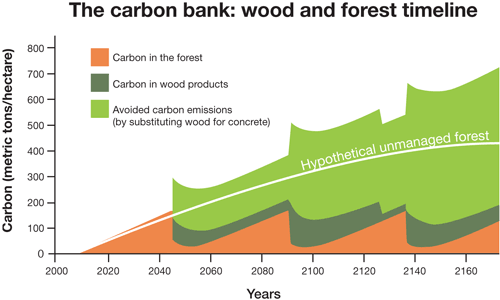Materials Matter
Growing a Forest—Carbon Benefits
Healthy growing forests recycle carbon naturally. When biomass is used instead of fossil fuels, it reduces the amount of carbon dioxide emitted to the atmosphere. When trees are used for forest products, the carbon often remains stored in the products for decades, or longer. This is recognized by the Intergovernmental Panel on Climate Change (IPCC), a scientific body set up by the World Meteorological Organization and United Nations Environment Program. A 2007 report by the IPCC Working Group III says forests remove carbon from the atmosphere and, at the same time, provide products that meet society's needs for timber, fiber and energy. A stable market for forest products encourages landowners to manage forests sustainably rather than converting them to other uses such as agriculture or urban development.
 |
Source: "Forests, Carbon and Climate Change: A Synthesis of Science Findings," 2006, Oregon Forest Resource Institute |
In Consultation with the Community
Forests are home to an estimated 800 million people worldwide. Some 60 million Indigenous people are dependent on forests, and in developing countries about 1.2 billion people rely directly on agroforestry farming systems. As Indigenous Peoples struggle to protect their customary land uses and rights, Indigenous participation in the decision-making process is growing.
Landmark progress in this area has been made in Great Bear Rainforest on the central and north coast of British Columbia, the largest area of undeveloped coastal temperate rainforest on the planet. Communities, First Nations, loggers, government and environmental groups all had passionate views on the future of the rainforest. Land use planning began in 1997 and, more than ten years in the making, a consensus-driven land use plan was adopted by the government and the First Nations to set aside 8,100 square miles, roughly one third of the forest, to create a system of protected areas. The new paradigm, called Ecosystem-Based Management (EBM), is "an adaptive, systematic approach to managing human activities that seeks to ensure the co-existence of healthy, fully functioning ecosystems and human communities." Following the fulfillment of the Coast Land Use Decision commitment to "fully establish an EBM system for the Central and North Coast area by March 31, 2009," April 1, 2009 marked the beginning of a new phase of government-to-government implementation of EBM. The focus of implementation has shifted to developing strategies to improve human well-being and a strategic landscape reserve design, designating grizzly bear no-hunting areas, concluding conservancy management planning, and improving land use objectives with results from an adaptive management program.
Job Opportunities
According to the United Nations, at least 10 million jobs could be created in sustainable forest management, with Asia, Africa and Latin America benefitting the most.15 Jobs could come in a number of areas from forest management and improved fire management to development of trails and recreation sites and restoration of degraded forests, with activities tailored to local circumstances, labor, and socio-economic conditions. Because restoring forests requires people as opposed to capital investment, which translates to jobs for soil scientists, tree planters, equipment operators, water engineers, and people to nurture the trees over time, several countries have included forestry in their economic stimulus packages. In the U.S., which earmarks stimulus dollars for forestry, reforestation and restoration is said to outperform even the second-most jobs-intense activity by 74 percent, and exceeds other major job alternatives including new highway construction, and financial services.
Materials Do Matter
In reducing the environmental footprint of tomorrow's structures, wood is a sustainable building choice. It outperforms concrete and steel when compared using LCA methodology. It stores carbon. Certified wood that has a chain-of-custody provides documentation of responsible procurement. The forestry industry creates jobs and well being for millions of people worldwide.
This is the first of a three-part series documenting the environmental footprint of wood, concrete, and steel. The second article, Materials in Action, will cover their performance during construction, operation and end-of-life, reaffirming that in the quest for carbon-neutral buildings, materials do matter.
|









